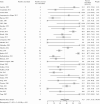Concordance of Drug-resistance Profiles Between Persons With Drug-resistant Tuberculosis and Their Household Contacts: A Systematic Review and Meta-analysis
- PMID: 32448887
- PMCID: PMC8427728
- DOI: 10.1093/cid/ciaa613
Concordance of Drug-resistance Profiles Between Persons With Drug-resistant Tuberculosis and Their Household Contacts: A Systematic Review and Meta-analysis
Abstract
Background: Household contacts of patients with drug-resistant tuberculosis (TB) are at high risk for being infected with Mycobacterium tuberculosis and for developing TB disease. To guide regimen composition for the empirical treatment of TB infection and disease in these household contacts, we estimated drug-resistance profile concordance between index patients with drug-resistant TB and their household contacts.
Methods: We performed a systematic review and meta-analysis of studies published through 24 July 2018 that reported resistance profiles of drug-resistant TB index cases and secondary cases within their households. Using a random-effects meta-analysis, we estimated resistance profile concordance, defined as the percentage of secondary cases whose M. tuberculosis strains were resistant to the same drugs as strains from their index cases. We also estimated isoniazid/rifampin concordance, defined as whether index and secondary cases had identical susceptibilities for isoniazid and rifampin only.
Results: We identified 33 eligible studies that evaluated resistance profile concordance between 484 secondary cases and their household index cases. Pooled resistance profile concordance was 54.3% (95% confidence interval [CI], 40.7-67.6%; I2 = 85%). Pooled isoniazid/rifampin concordance was 82.6% (95% CI, 72.3-90.9%; I2 = 73%). Concordance estimates were similar in a subanalysis of 16 studies from high-TB-burden countries. There were insufficient data to perform a subanalysis among pediatric secondary cases.
Conclusions: Household contacts of patients with drug-resistant TB should receive treatment for TB infection and disease that assumes that they, too, are infected with a drug-resistant M. tuberculosis strain. Whenever possible, drug susceptibility testing should be performed for secondary cases to optimize regimen composition.
Keywords: Mycobacterium tuberculosis genotyping; tuberculosis contact investigation; tuberculosis prevention and control; tuberculosis transmission.
© The Author(s) 2020. Published by Oxford University Press for the Infectious Diseases Society of America. All rights reserved. For permissions, e-mail: journals.permissions@oup.com.
Figures







Similar articles
-
Co-resistance to isoniazid and second-line anti-tuberculosis drugs in isoniazid-resistant tuberculosis at a tertiary care hospital in Thailand.Microbiol Spectr. 2024 Mar 5;12(3):e0346223. doi: 10.1128/spectrum.03462-23. Epub 2024 Feb 7. Microbiol Spectr. 2024. PMID: 38323824 Free PMC article.
-
Drug susceptibility patterns of Mycobacterium tuberculosis from adults with multidrug-resistant tuberculosis and implications for a household contact preventive therapy trial.BMC Infect Dis. 2021 Feb 24;21(1):205. doi: 10.1186/s12879-021-05884-4. BMC Infect Dis. 2021. PMID: 33627075 Free PMC article.
-
Transmissibility and potential for disease progression of drug resistant Mycobacterium tuberculosis: prospective cohort study.BMJ. 2019 Oct 24;367:l5894. doi: 10.1136/bmj.l5894. BMJ. 2019. PMID: 31649017 Free PMC article. Clinical Trial.
-
Treatment and outcomes in children with multidrug-resistant tuberculosis: A systematic review and individual patient data meta-analysis.PLoS Med. 2018 Jul 11;15(7):e1002591. doi: 10.1371/journal.pmed.1002591. eCollection 2018 Jul. PLoS Med. 2018. PMID: 29995958 Free PMC article.
-
High resolution melting assay as a reliable method for diagnosing drug-resistant TB cases: a systematic review and meta-analysis.BMC Infect Dis. 2021 Sep 22;21(1):989. doi: 10.1186/s12879-021-06708-1. BMC Infect Dis. 2021. PMID: 34551717 Free PMC article.
Cited by
-
Pediatric multi-drug-resistant tuberculosis in Germany - diagnostic and therapeutic challenges of an "orphan disease".Eur J Pediatr. 2023 Nov;182(11):5167-5179. doi: 10.1007/s00431-023-05167-x. Epub 2023 Sep 14. Eur J Pediatr. 2023. PMID: 37707590 Free PMC article.
-
Toward patient-centered tuberculosis preventive treatment: preferences for regimens and formulations in Lima, Peru.BMC Public Health. 2021 Jan 11;21(1):121. doi: 10.1186/s12889-020-10098-5. BMC Public Health. 2021. PMID: 33430823 Free PMC article.
-
Systems analysis and improvement approach to optimize tuberculosis (SAIA-TB) screening, treatment, and prevention in South Africa: a stepped-wedge cluster randomized trial.Implement Sci Commun. 2024 Apr 16;5(1):40. doi: 10.1186/s43058-024-00582-z. Implement Sci Commun. 2024. PMID: 38627799 Free PMC article.
-
Active tuberculosis in household contacts of bacteriologically confirmed pulmonary tuberculosis patients: A multicenter study finding the 'Missed One' in Central Ethiopia.PLoS One. 2025 Feb 18;20(2):e0316903. doi: 10.1371/journal.pone.0316903. eCollection 2025. PLoS One. 2025. PMID: 39964990 Free PMC article.
-
Current Treatment of Drug-Resistant Tuberculosis in Children.Indian J Pediatr. 2024 Aug;91(8):806-816. doi: 10.1007/s12098-023-04888-z. Epub 2023 Nov 23. Indian J Pediatr. 2024. PMID: 37995068 Free PMC article. Review.
References
-
- World Health Organization. Global tuberculosis report 2019. Geneva, Switzerland: WHO, 2019. Available at: https://www.who.int/tb/publications/global_report/en. Accessed 27 November 2019.
-
- Keshavjee S, Dowdy D, Swaminathan S. Stopping the body count: a comprehensive approach to move towards zero tuberculosis deaths. Lancet 2015; 386:e46–7. - PubMed
-
- World Health Organization. Latent TB infection: updated and consolidated guidelines for programmatic management. Available at: https://www.who.int/tb/publications/2018/latent-tuberculosis-infection/en/. Accessed 14 September 2019. - PubMed
-
- Rodriguez CA, Sasse S, Yuengling KA, Azzawi S, Becerra MC, Yuen CM. A systematic review of national policies for the management of persons exposed to tuberculosis. Int J Tuberc Lung Dis 2017; 21:935–40. - PubMed
Publication types
MeSH terms
Substances
Grants and funding
LinkOut - more resources
Full Text Sources
Medical

